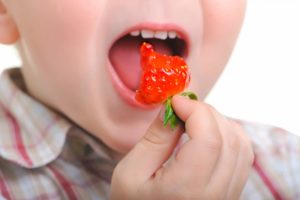Nutrition is an important topic at any stage of life, and even more so in childhood. Children require extra care and healthy eating to ensure good health so they can grow and develop properly, as well as to provide all the energy they need. But within the wide variety of foods, there are certain foods not recommended for children. Do you know which ones these are and why they shouldn’t be offered? From 6 months onward, it is recommended to introduce new foods into the baby’s diet, and care regarding what you offer and the reactions to each food should be extended for many years. Even for older children who already eat everything, caution is needed, especially regarding sweets, fast food, and candies full of food coloring. Some foods that seem “harmless” for adults can cause big problems for little ones. Let’s list the main foods not recommended for children.
What to Avoid Giving to Children
- Packaged snacks: Packaged snacks contain a large amount of salt, coloring, and some are loaded with fat when fried. They provide no nutritional value and increase the risk of cardiovascular problems, high blood pressure, and cholesterol even in childhood. TIP: Instead of offering pre-packaged snacks, opt for homemade ones. You can make homemade chips using fruits or vegetables that can be baked or microwaved, such as potatoes, sweet potatoes, or apples.
- Artificial sweeteners: Even when it is recommended not to use sugar in children’s diets, it should not be replaced with an artificial sweetener unless prescribed by a doctor. In some specific cases, such as diabetes, a substitute may be necessary with a specific sweetener.
- Peanuts: It’s very easy to find snacks and sweets made with peanuts. They taste great and are very appealing to children’s palates, but they pose a high risk of allergies, just like nuts and other tree nuts, which are allergenic foods. Many children develop severe allergies, and in some serious cases, this can lead to difficulty breathing and swelling of the tongue and mouth, posing a serious life risk.
- Canned foods: Like processed meats, canned foods are high in salt, hinder digestion, and offer little nutritional value, in addition to all the preservatives used to extend shelf life. Totally not recommended for children’s diets.
- Gelatin: Contrary to what many mothers believe, gelatin is not a healthy food for children. It contains preservatives and food coloring and can trigger atopic allergic reactions on children’s skin. Replace fruit-flavored gelatin with chopped fruit instead.
- Processed meats: Processed meats are high in preservatives and fats with no nutritional value whatsoever. That’s why hot dogs, bologna, ham, and others should be excluded from children’s diets.
- Chocolate drink mixes: Foods with a high sugar content should be avoided as much as possible. It is best not to add them to babies’ milk and especially not to add any sugar.
- Sweets: It’s hard to find a child who refuses these foods, but candy, lollipops, and cakes are not recommended for children. Besides being high in sugar—which doesn’t benefit the child’s health at all—sweets are addictive, ruin teeth, and are one of the main causes of childhood obesity.
The foods mentioned are the “most attractive” to children and should be given with total caution. If possible, avoid them as much as you can, and if offered, do so in controlled amounts while always watching for signs of allergies. For children who accompany their parents on “culinary adventures,” it’s important to watch every ingredient consumed, such as with Japanese food. Most traditional Japanese dishes contain raw fish and should be avoided. Choose cooked dishes or other menu options that children often enjoy. 
Food Allergies
When we talk about allergies, we imagine rashes or even itchy skin. But allergic reactions can be much more dangerous than just some discomfort, and they can be life-threatening if not addressed in time. Even natural foods that seem so harmless can cause fatal allergic reactions. In some cases, symptoms may look like simple food intolerance or even a stomach virus, when in fact they’re signs of a reaction to what was eaten. The cause of food allergies is related to the production of a type of substance by the body called immunoglobulin E antibodies (IgE), which react by causing an allergy to a specific food. While many people have intolerances to foods, actual food allergies are not common. In a true food allergy, the immune system produces antibodies and histamine in response to the food ingested.
Main Foods That Cause Allergies
Any food can cause an allergic reaction, but some are identified as the main and most dangerous culprits, both in children and adults. These are eggs, milk, peanuts, shellfish (shrimp, fish, crab, lobster), soy, nuts, and gluten. Some people only discover their food allergies after having a reaction, but it is possible to find out in advance through allergy tests. Usually, symptoms appear immediately or up to two hours after eating. The main symptoms are:
- Hives;
- Hoarseness;
- Difficulty or noisy breathing;
- Abdominal pain;
- Diarrhea;
- Difficulty swallowing
Other symptoms to watch for are dizziness, fainting, nasal congestion, nausea and vomiting, scaly itchy patches (atopic dermatitis), blisters, and swelling (angioedema), especially around the eyelids, face, lips, and tongue. Allergies are more dangerous in children and babies; as we get older, the digestive system matures and the body becomes less likely to absorb foods or components that trigger allergies. But at any age, we must watch out for allergic reactions. See also: Foods to Relieve Constipation Photo: pxhere











